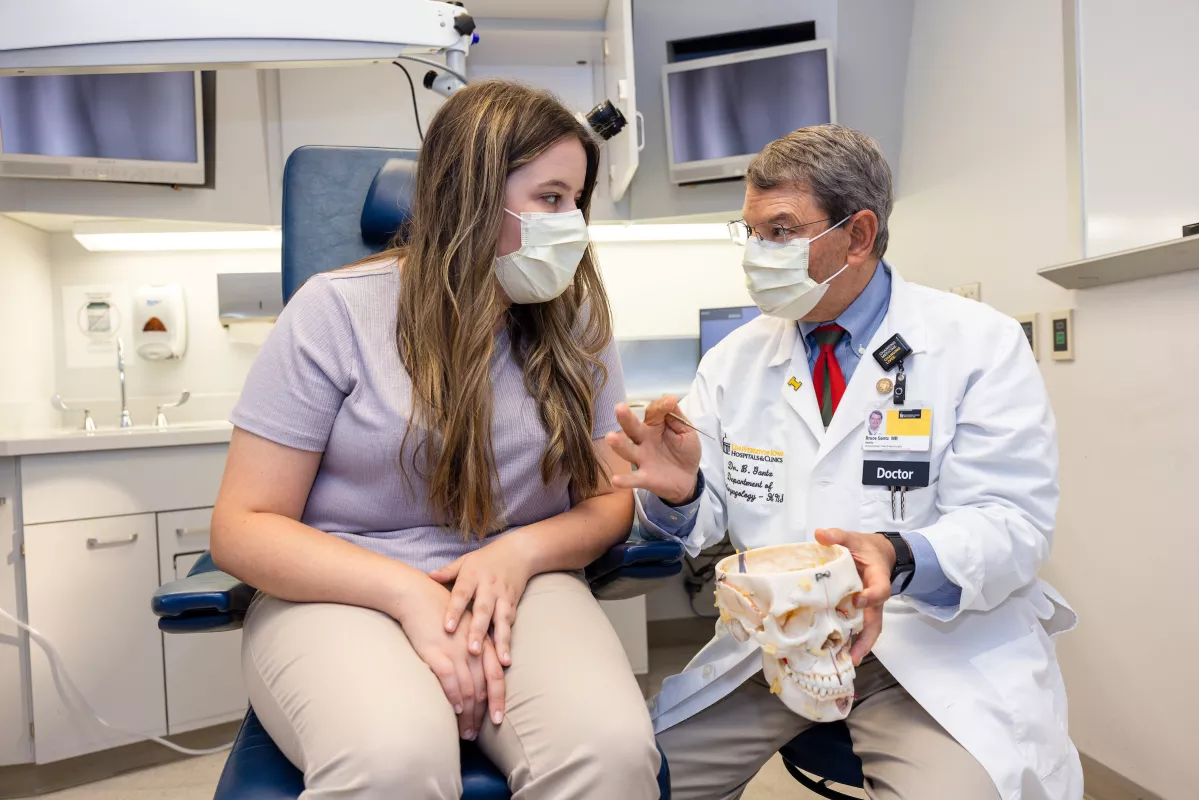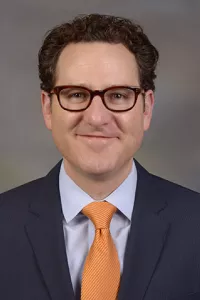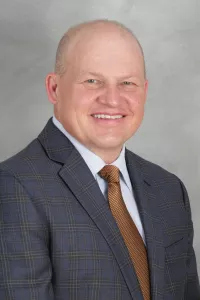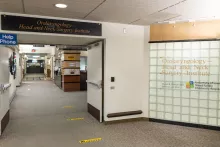Facial Nerve Disorders and Facial Paralysis
- For all other requests:
- 1-800-777-8442
People of all ages can lose the ability to move muscles in their face—a condition known as facial paralysis. This can be caused by medical conditions such as viruses, bacterial infections, tumors, traumatic injuries, and more.
Facial paralysis makes it hard to perform the everyday facial movements that many of us take for granted.
For example, if you have facial paralysis, you may have trouble with:
- Blinking or closing your eye (leading to complications like chronic dry eye or corneal damage)
- Eating, drinking, or swallowing
- Smiling and other facial expressions
- Speaking

In the past, facial paralysis was often difficult to treat. However, new treatments available from University of Iowa Health Care make it possible to restore some or all facial movements.
We have a team of experts that specializes in facial nerve disorders. These team members include:
- Otolaryngologists with advanced training in facial plastic and reconstructive surgery, and surgery of the ear and skull base.
- Neuromuscular therapists who can help you relearn how to move your face muscles after facial paralysis.
We’ve successfully helped people who were told their facial paralysis is not treatable. And we’ve been able to improve or restore movement for people who have lived with facial paralysis for years.
Leading expertise, right here in Iowa
It takes a skilled team to pinpoint the cause of facial paralysis—and recommend the right treatments at the right time.
That’s because facial paralysis:
- Has many different causes: Facial paralysis usually happens after an illness or injury damages your main facial nerve. But it can also occur if something harms the part of your brain that controls your facial nerve.
- Affects each person differently: You may have muscle weakness or paralysis on just one side of your face, or on both sides. Symptoms can vary from person to person—some people may experience a looseness or weakness (flaccidity) of the facial nerve, whereas others may experience muscle tightness or poor facial muscle coordination.
- May go away on its own: For some types of facial paralysis, patients must have surgery promptly to ensure the best results. In other cases—such as in people with Bell’s palsy—we can take a wait-and-see approach because most people recover without surgery. Also, with Bell’s palsy, early treatment with antiviral medications and steroids usually reduces the need for surgery.
No matter what caused your facial paralysis or how long you’ve had it, you can count on our team for expert care and support.
No matter how mild your symptoms, it’s important to have them evaluated by a specialist within a few days of onset. In many cases, the sooner you begin medical treatment, the sooner you can regain facial movement—and avoid the need for surgery.
If you have sudden, complete loss of facial movement, you’ll need special facial nerve testing within five to 14 days. That’s because some severe conditions won’t improve unless they’re treated right away. For example, with severe Bell’s palsy, the odds of recovery are much higher if you have a procedure called surgical decompression within 14 days of onset.
In recent years, there has been remarkable growth in the field of facial nerve disorders. But there is still a very limited number of facial nerve surgeons and dedicated facial nerve teams in the United States.
This means only the most specialized experts—like those with UI Health Care—can keep up with the latest research findings and surgical techniques.
Our providers are often among the first to learn about new or better ways to diagnose and treat facial paralysis. And because we take part in clinical trials and other types of research, our patients are often among the first to try promising new treatments.
While facial paralysis surgery is safer and more effective than ever before, the latest techniques aren’t available at many medical centers.
Fortunately, UI Health Care offers them all. Our areas of expertise include:
- Corneal neurotization: This procedure lets us restore sensation to the clear covering on the front of your eye (cornea). By transferring a nerve from your leg to the eye area, we can improve your ability to blink and produce tears.
- Facial nerve decompression: We enlarge part of the bony space that your facial nerve runs through. This takes pressure off the nerve, which can relieve your symptoms and prevent permanent nerve damage.
- Facial nerve transfer: We take a healthy nerve from another part of your face and attach it to your damaged facial nerve. When the two nerves are joined, the damaged nerve often begins working again.
- Free muscle transfer: We take a piece of muscle containing blood vessels and nerves from your leg and move it to your face. This new tissue replaces facial muscle that no longer works. This procedure is often performed with a nerve transfer.
- Periocular reanimation: We use several techniques to treat paralysis around the eyes. For example, tiny weights inserted in your upper eyelid can help you fully close your eye.
- Selective neurectomy: We divide certain tiny nerves that are impacting facial function. With this procedure, we can preserve sections of nerve that are working well while cutting away sections that are damaged.
- Static reanimation: In some cases, even if we can’t restore facial movement, we can still improve facial symmetry and certain functions. For example, we can lift a droopy eyelid that makes it hard to see or reposition a nasal cavity so you can breathe better.
We also offer surgical treatments for people whose facial paralysis was present at birth (congenital).
Specialized therapy helps restore facial function
UI Health Care offers a unique type of therapy called neuromuscular retraining. It’s provided by physical, occupational, and speech therapists with a deep understanding of facial nerve disorders. Over time, it can help you greatly improve facial movement—and your quality of life.
Neuromuscular retraining can benefit many patients. This includes people who:
- Are recovering from facial paralysis surgery.
- Still have some muscle weakness or paralysis after recovering from Bell’s palsy.
- Have a complication called synkinesis (involuntary muscle movements that occur at the same time as intentional muscle movements). For example, your eye may close every time you smile.
How neuromuscular retraining works
With neuromuscular retraining, we teach you precise, targeted facial exercises. These exercises help your brain relearn to communicate with your facial nerves and muscles.
Our therapists can teach you how to improve and control certain desired facial movements. For example, we can help you speak more clearly or drink your favorite beverage more easily.
When necessary, we also teach you how to reduce or prevent any involuntary facial movements caused by synkinesis. In some cases, we pair these exercises with “chemodenervation therapy,” more commonly known as Botox injections.
Depending on the stage or severity of your facial paralysis, you may also receive:
- Education about your condition
- Information about your expected recovery, including timelines and any complications to watch out for
- Supportive care services to help you manage side effects like eye dryness, drooling, and dry mouth
A team approach to treating facial paralysis
Whether your facial paralysis is sudden and unexplained, or you already know the cause, help is available.
Our otolaryngologists work with other UI Health Care specialists to diagnose and treat your condition. Depending on your needs, one or more of the following providers may also be involved in your care:
- Audiologists who can help you manage increased sensitivity to sound (hyperacusis), a common complication of facial nerve damage
- Facial plastic and reconstructive surgeons who specialize in surgical techniques that restore facial movement
- Head and neck surgeons who can safely remove cancerous or noncancerous tumors pressing on your facial nerve
- Neurologists who diagnose and treat neurological conditions that can cause facial paralysis, such as a brain tumor or stroke
- Neurosurgeons who can also remove brain tumors and skull base tumors that have harmed the facial nerve
- Neurotologists who treat conditions that can harm hearing and facial movement (such as acoustic neuroma) and can decompress the bony facial nerve channel in some severe cases of Bell’s palsy.
- Ophthalmologists who perform plastic and reconstructive surgery around the eye area (oculoplastic surgery)
Facial nerve tests and treatments
- Botox injection (chemodenervation)
- CT scan
- Electromyogram (EMG)
- Facial nerve decompression
- Facial nerve repair
- Facial nerve transfer
- Free muscle transfer
- MRI scan
- Neuromuscular retraining
- Occupational therapy
- Periocular reanimation
- Physical therapy
- Selective neurectomy
- Speech therapy
- Vestibular therapy
Facial nerve conditions treated
- Acoustic neuroma (vestibular schwannoma)
- Asymmetric crying facies (ACF)
- Bell’s palsy
- Birth trauma
- CHARGE syndrome
- Congenital unilateral lower lip palsy (CULLP)
- DiGeorge syndrome (22q11.2 deletion syndrome)
- Facial nerve tumors
- Facioscapulohumeral muscular dystrophy (FSHD)
- Goldenhar syndrome
- Hemifacial spasm
- Hemifacial microsomia
- Lyme disease
- Melkersson-Rosenthal syndrome
- Moebius syndrome
- Oculopharyngeal muscular dystrophy (OPMD)
- Parotid tumor
- Poland syndrome
- Ramsey Hunt syndrome
- Postoperative surgical complication
- Temporal bone fracture
- Traumatic facial injury
Our Care Team

- Cosmetic Surgery & Services
- Ophthalmology and Visual Sciences


- Cosmetic Surgery & Services
- Ophthalmology and Visual Sciences

- Cosmetic Surgery & Services
- Ophthalmology and Visual Sciences




Not sure which Facial Nerve Disorders and Facial Paralysis provider is right for you?
Locations and Offices

